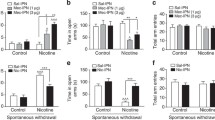Abstract.
Rationale: Smokers frequently report that they obtain anxiety-reducing (anxiolytic) effects from smoking, and this may be one factor which contributes to nicotine dependence. Objective: The aim of this study was to investigate the role of the dorsal raphé nucleus (DRN) in mediating the acute anxiolytic effect of nicotine, the development of tolerance to this effect and the anxiogenic response observed on withdrawal from chronic nicotine. Methods: The social interaction test of anxiety was used to investigate the effects of a range of doses of (-)-nicotine (2.5–4000 ng) following DRN infusion, and whether co-administration of the specific 5-HT1A receptor antagonist WAY 100635 could antagonise the anxiolytic action of nicotine. We then examined the effects of intra-DRN nicotine (2.5–7 ng) following six daily injections of subcutaneous (s.c.) (-)-nicotine (0.1 mg/kg). Finally, we examined whether s.c. or intra-DRN (-)-nicotine could antagonise the anxiogenic response seen 72 h after the termination of 7 days of nicotine treatment. Results: Acute nicotine administration into the DRN produced dose-related effects: low doses (2.5–10 ng) induced an anxiolytic effect, intermediate doses were behaviourally silent (100–1000 ng), and an anxiogenic effect was seen following administration of a high dose (4 µg). The anxiolytic effect of (-)-nicotine (5 ng) was reversed by co-administration of a behaviourally inactive dose of WAY 100635 (200 ng). Following 6 days of treatment with s.c. 0.1 mg/kg per day (-)-nicotine, tolerance developed to its anxiolytic action in the DRN. Rats withdrawn for 72 h following this chronic treatment showed an anxiogenic response which was reversed by (-)-nicotine injected s.c. (0.1 mg/kg) or into the DRN (5 ng). Conclusions: The present findings therefore suggest that the DRN plays an important role in mediating the acute effects of nicotine on anxiety, as measured in the social interaction test, and that the anxiolytic effect is mediated by activation of somatodendritic 5-HT1A autoreceptors. The DRN is also concerned with mediating the development of tolerance to nicotine's anxiolytic effects and because there is an anxiogenic response 72 h after withdrawal from chronic nicotine, this suggests that an oppositional, compensatory mechanism is mediating the tolerance.
Similar content being viewed by others
Author information
Authors and Affiliations
Additional information
Electronic Publication
Rights and permissions
About this article
Cite this article
Cheeta, S., Irvine, E., Kenny, P. et al. The dorsal raphé nucleus is a crucial structure mediating nicotine's anxiolytic effects and the development of tolerance and withdrawal responses. Psychopharmacology 155, 78–85 (2001). https://doi.org/10.1007/s002130100681
Received:
Accepted:
Published:
Issue Date:
DOI: https://doi.org/10.1007/s002130100681




